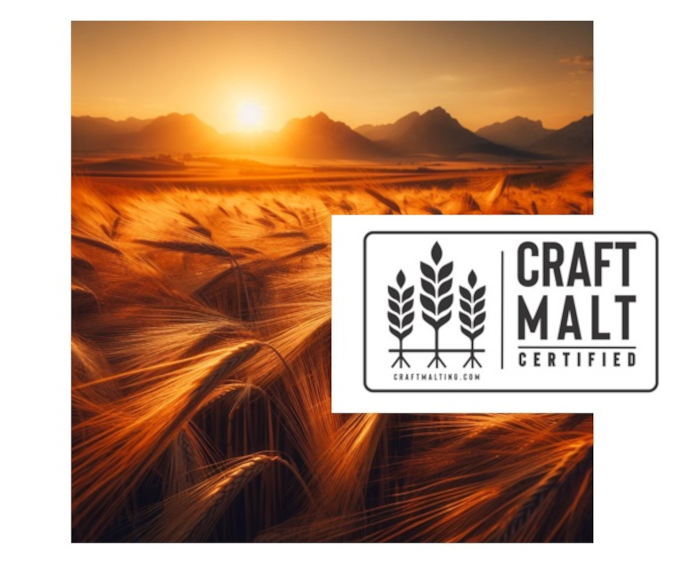A Grassroots Movement to Produce Craft Malt is Rapidly Expanding
Craft Malt
For years, the use of new hop varieties drove one of the hottest trends in the craft beer industry. And although that trend is unlikely to change, a new trend is emerging. Small-batch, independent farmers and maltsters are coming together to produce malts that deliver unique flavor profiles and offer sustainability benefits.
A recent survey conducted and reported by the Craft Maltsters Guild shows the number of craft malt producers in North America has been on the rise. In 2015, the Guild had 8 founding member malt houses. Since then, the number of operating craft malt houses has climbed steadily over the past eight years and grown to more than 65 in Canada and the United States. And craft malt production is growing internationally too.
Click on this link to find a North American craft malt house near you.
 The number of Craft Maltsters Guild malt houses in North America has increased about 740 per cent since 2015. Craft malting is also growing internationally. Image courtesy of Craft Maltsters Guild.
The number of Craft Maltsters Guild malt houses in North America has increased about 740 per cent since 2015. Craft malting is also growing internationally. Image courtesy of Craft Maltsters Guild.
What is Craft Malt ?
Produced by small-scale maltsters, craft malt is made from heirloom varieties of grains. These grains are usually not commercially viable for large growers. And many small farmers are providing organic, heirloom grain production to get a higher income for their grains. Plant flavor, including barley, can vary from region to region due to soil composition, climate, topography, and other factors. The word terroir refers to flavor imparted by a specific region. Terroir is a French word for “a sense of place.” It comes from the Latin word “terra”, which means land or earth. Essentially, terroir is about how the environment in a particular place influences the taste and unique character of the crop grown there.
Craft maltsters employ everything from traditional floor malting techniques to precision malting with the most sophisticated equipment in the world. In many cases craft maltsters may employ labor-intensive malting techniques, such as traditional floor malting and hand turning. These techniques are employed to develop unique flavor components. Floor malting gives malt a very rich, aromatic flavor that is far more intense than usually achieved by industrial malting.
Many breweries and distilleries seek to improve and differentiate their products by employing craft malt. Hence, passionate small-scale farmers, maltsters, breweries and distilleries work together to revive the heirloom grain supply chain and historic malting techniques. Their goals:
- improving malt and other grain quality through artisan methods,
- expanding heirloom malt usage,
- creating a positive environmental impact,
- differentiating their product offerings,
- cultivating a farm-to-table experience for the consumer, and
- improving the taste of beer and spirits.
What is a Craft Maltster?
As defined by the guild, a member Malt house must meet the following criteria to become certified:
- Small: A Member Malt house produces between 5 metric tons (5.5 US tons) to 10,000 metric tons (11,000 US tons) per year.
- Local: Over 50% of grains are grown within a 500-mile radius of the Member Malt house.
- Independent: Each Member Malt house must be independently owned by a 76% majority of ownership.
Industry Impact
The Craft Maltsters Guild launched the Craft Malt Certified™ seal program in September 2019. “The seal is designed to provide a key point of differentiation for Guild Member Malt Houses and the brewers and distillers they work with. Its usage on products and in other marketing helps bridge the “grain to glass” divide and connect local grain farming families with brewers, distillers, and their customers.”
 Small-scale farmers, maltsters, breweries and distilleries seek to revive the heirloom grain supply chain and historic malting techniques to differentiate their products and improve the customer experience.
Small-scale farmers, maltsters, breweries and distilleries seek to revive the heirloom grain supply chain and historic malting techniques to differentiate their products and improve the customer experience.
Based on a 2022 industry survey conducted by the Craft Maltsters Guild, craft malt production had increased by an impressive 60 percent since 2019. The survey also revealed that despite the difficulties craft maltsters faced during the pandemic, a majority recovered with nearly 87 percent experiencing sales comparable to pre-pandemic levels. Along with boosted production and recouped sales, the survey showed malt houses are also making significant investments in their operations.
Craft Malt Certified Breweries & Distilleries
There are 130 certified breweries and 17 certified distilleries throughout North America at this time.
 Click here to find a North America certified brewery or distillery near you. Image courtesy of Craft Maltsters Guild.
Click here to find a North America certified brewery or distillery near you. Image courtesy of Craft Maltsters Guild.
Here are a few examples of certified breweries and distilleries.
- Arizona Wilderness Brewing Company – This Arizona brewery focuses on using locally grown ingredients and ensuring environmental sustainability. Every Arizona Wilderness beer uses Sinagua Malt as a base. Based in Arizona’s Verde Valley, Sinagua works with local farmers to shift from traditional summer crops like corn and alfalfa to barley, a late winter/spring crop. This crop-switching results in less water diverted from the Verde River during high-demand, low stream-flow periods, leaving more water for people and wildlife. Since 2019, Sinagua’s efforts have kept more than 425 million gallons of water in the Verde River. “This Beer Saves Water”, an American Pale Ale, is made with 100% Sinagua malt, as well as Sabro and Zappa hops, both of which are relatively drought-resistant.
- Wheatland Spring Farm and Brewery – Wheatland Spring is Virginia’s first certified Craft Maltsters Guild brewery. They grow acres of barley on their farm, using regenerative (no spray) practices, right next to the brewhouse. This turns into their Estate malt, with each batch custom craft malted for specific beers they brew. Whether the grain is Estate or grown by other farms in the region, Wheatland uses craft malt in every beer.
- Still Austin Whiskey Company – In 2014, Still Austin opened its doors as the first whiskey distillery in Austin, TX city limits since prohibition. And Still Austin is one of the only distilleries in Texas to source grains from local farmers, distilled ecologically in-house, and aged in the Texas Hill Country. Their commitment to sourcing the highest quality, Texas-grown grains along with their team’s ability to mash, mill, distill, and age their products in the dynamic Texas climate has paid off in numerous awards for the quality of their spirits.
Experience the Difference
So, if you are looking for an environmental-friendly, farm-to-table experience for your next beer or distilled spirit drink then visit a Craft Malt Certified Brewery or Distillery. Click here to find a North America certified brewery or distillery near you.
And if you are looking for a more in-depth, hands-on learning experience about craft malt then consider going to MaltCon2024 – the Craft Maltsters Guild’s annual conference and trade expo.
